Get off the beaten track at charming Maratea in southern Italy
About Maratea
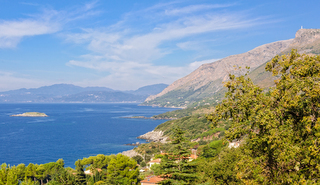
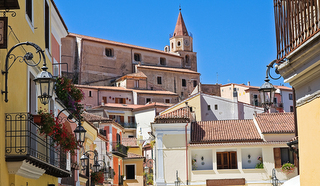
Maratea is jewel of a coastal town, set high above the Tyrrhenian Sea in Italy’s Basilicata region, with views to rival those of the Amalfi Coast. The nearest airport is 200km away in Naples, which is partly responsible for its away from it all charm.
In fact, the town has remained largely unchanged over the last 50 or so years. While there’s a hum of activity in the old town during the summer months, it certainly doesn’t attract the crowds that flock to the towns on the Sorrento peninsula. We think it’s the perfect starting point for our Southern Italy tour, an initial introduction to the landscape, history, food and wine of southern Italy.
Geographically, the town comprises various settlements but the historic centre is the place to head for, set high up in the hills with views over the Gulf of Policastro. This is where you’ll find numerous churches (an impressive 44!) and a tangle of winding lanes lined with crumbling buildings, boutiques and restaurants, leading from the main Piazza Buraglia. Meanwhile, the winding coastal road below the town is home to a series of hideaway crescent shaped beaches with crystal clear water, and a marina style port.
Where is Maratea?
Maratea is in the Basilicata region, around 200km south of Naples, comprising a settlement that stretches for around 20km along the coastline, taking in the tiny hamlets of Castrocucco, Porto, Fiumicello and Acquafredda. This coastline is often overlooked by tourists but in fact the views from the coastal road are simply spectacular. Beyond the town, the Basilicata region is probably best known for its nature reserves and superb hiking opportunities.
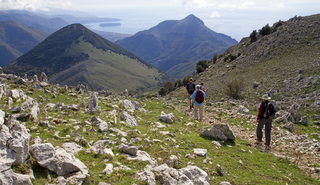
History of Maratea
The exact history of the origins of Maratea has been clouded by legends that have been handed down through the centuries. One theory is that it dates back to the VIII century BC and to the ancient Greeks who established a small colony at the top of Monte San Biagio, while an alternative thought dates the town to the ancient Christian city of Blanda which vanished from records in the VIII century AD. The most likely version is something between the two – that the early inhabitants of the Greek colony merged with those from Blanda, creating one population.
The town’s geographical location made it a popular option for invading Normans, Angevin and Spanish, and in time, a significant trading port. Over the years, Roman remains, Byzantine frescoes and other relics have been found. However it was between the XVII and the XVII centuries that most development took place, and some of this is still in evidence in the churches and buildings in Maratea’s old town.
Things to do in Maratea
Churches in Maratea
Squeezing 44 churches into the town and neighbouring suburbs of Maratea is no mean feat! If you were to choose 3 to visit, we’d recommend the Chiesa dell’Addolorata, the Chiesa dell’Immacolata and the Chiesa dell’Annunziata, all near the main piazza. Several of the smaller chapels are also worth a visit, such as the Chiesetta del Calvario which is home to some wonderful frescoes, or the 11th century Chiesa di San Vito, set by the woods.
Visit the Il Redentore statue
You couldn’t fail to be overwhelmed by the sheer beauty of the giant statue of Il Redentore (Christ the Redeemer) which seems to float above the town from its lofty position on Monte San Biagio. At night, the 22 metre high statue is illuminated against inky blue skies. By day, we’d recommend walking up to the statue to get the full measure of its scale, and to also visit the Basilica di San Biagio.
For the downward descent, after a few twists and turns on the road, head right on the path just before the hamlet of Santa Caterina. Home to several caves such as the Grotta dell’Angelo, this is the historic route that connected the old and new settlement.
Walking in Maratea
The route to Il Redentore is just one of the walks that take you out of town. On our Southern Italy tour, we head out of town on a medieval trail that climbs through chestnut and oak woods, before continuing on to an old mule track that descends to the coastal hamlet of Aquafredda. We also hike to the mountain village of Trecchina, following a pilgrim trail that climbs to the Madonna del Soccorso, returning along a shepherds’ trail and descending to Maratea to join a mountainside mule track with coastal views.
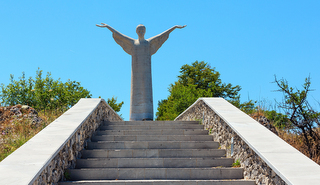
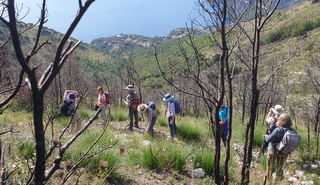
What to eat and drink in Maratea
Maratea’s food is strongly influenced by the region’s history and geography, with locally produced vegetables, fruit, cheese and oil taking centre stage. Expect to see plenty of tomatoes, artichokes, greens, beans and, of course, all sorts of fish including anchovies and sea bass, often baked with breadcrumbs, almonds and garlic. All those delicious vegetables are often made into ‘ciammotta’, a hearty summer stew of fried aubergines with potatoes, tomatoes and peppers, or dishes of courgettes baked with egg and sheep’s cheese.
When it comes to wine, stick to the local Aglianico del Vulture (DOC), a dark rich and spicy red wine made from the Aglianico black grape.
The streets around the historic centre of Maratea offer a good choice of restaurants and pizzerie. If you prefer a sea view while you eat, head down to the port area where you’ll find a cluster of sea-facing restaurants and bars.
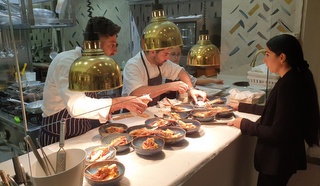
Beaches in and around Maratea
The coastline below Maratea town presents a series of tiny coves and beaches, featuring a mix of normal sand, black sand or pebbles and most offering sunbeds, umbrellas, showers and bars or simple beach restaurants. The one thing they all have in common is sparkling clear water which is great for swimming, snorkelling and diving. However, probably the best way to explore the coastline is to hire a boat for the day and flit between the sandy bays and sea caves on your own.
Getting to Maratea
The closest international airports to Maratea are Naples, Bari and Brindisi in Puglia, or Lamezia Terme in Calabria. If you’re travelling by train, there are multiple trains each day from Rome and Naples.
